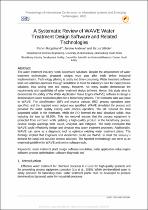 ResearchSpace
ResearchSpace
Systematic review of WAVE water treatment design software and related technologies
JavaScript is disabled for your browser. Some features of this site may not work without it.
- ResearchSpace
- →
- Research Publications/Outputs
- →
- Conference Publications
- →
- View Item
| dc.contributor.author |
Roopchund, R

|
|
| dc.contributor.author |
Andrew, Jerome E

|
|
| dc.contributor.author |
Sithole, Bruce B

|
|
| dc.date.accessioned | 2024-02-05T06:26:18Z | |
| dc.date.available | 2024-02-05T06:26:18Z | |
| dc.date.issued | 2023-01 | |
| dc.identifier.citation | Roopchund, R., Andrew, J.E. & Sithole, B.B. 2023. Systematic review of WAVE water treatment design software and related technologies. <i>SSRN.</i> http://hdl.handle.net/10204/13548 | en_ZA |
| dc.identifier.issn | 1556-5068 | |
| dc.identifier.uri | http://dx.doi.org/10.2139/ssrn.4332839 | |
| dc.identifier.uri | http://hdl.handle.net/10204/13548 | |
| dc.description.abstract | The water treatment industry needs customized solutions. Despite the advancement of water treatment technologies, proposed designs must pass pilot trials before industrial implementation. Technology piloting is costly and time-consuming. Water treatment software tools can optimize processes through simulation to meet the industry's need for rapid process solutions, thus saving time and money. However, not many studies demonstrate the requirements and capabilities of water treatment design software. Hence, this study aims to demonstrate the ability of the Water Application Value Engine (WAVE) software to design a demineralized water production plant for a Biorefinery process. The feedwater data was input in WAVE. The ultrafiltration (UF) and reverse osmosis (RO) process operations were specified, and the required water output was specified. WAVE simulated the process and provided the water quality exiting each process operation. The UF reduced the total suspended solids in the feedwater, while the RO lowered the total dissolved solids, thus reducing the ions by 98.56%. This ion removal ensures that the process equipment is protected from corrosion while yielding a high-quality product in the biorefinery process. Several design warnings were issued, analyzed, and mitigated. The study concluded that WAVE could effectively design and simulate new water treatment processes. Additionally, WAVE can serve as a diagnostic tool to optimize existing water treatment plants. The findings implied that Engineers and Academics could use WAVE to meet the industry’s demand for rapid and accurate process solutions. The reported methodology can serve as an empirical guideline for WAVE and similar software tools. | en_US |
| dc.format | Fulltext | en_US |
| dc.language.iso | en | en_US |
| dc.relation.uri | https://papers.ssrn.com/sol3/papers.cfm?abstract_id=4332839 | en_US |
| dc.source | SSRN | en_US |
| dc.subject | Process optimization | en_US |
| dc.subject | Software diagnostic tool | en_US |
| dc.subject | Software simulation | en_US |
| dc.subject | Water application value engine software | en_US |
| dc.subject | Water treatment plant design | en_US |
| dc.title | Systematic review of WAVE water treatment design software and related technologies | en_US |
| dc.type | Article | en_US |
| dc.description.pages | 12 | en_US |
| dc.description.cluster | Chemicals | en_US |
| dc.description.impactarea | BT Biorefinery | en_US |
| dc.identifier.apacitation | Roopchund, R., Andrew, J. E., & Sithole, B. B. (2023). Systematic review of WAVE water treatment design software and related technologies. <i>SSRN</i>, http://hdl.handle.net/10204/13548 | en_ZA |
| dc.identifier.chicagocitation | Roopchund, R, Jerome E Andrew, and Bruce B Sithole "Systematic review of WAVE water treatment design software and related technologies." <i>SSRN</i> (2023) http://hdl.handle.net/10204/13548 | en_ZA |
| dc.identifier.vancouvercitation | Roopchund R, Andrew JE, Sithole BB. Systematic review of WAVE water treatment design software and related technologies. SSRN. 2023; http://hdl.handle.net/10204/13548. | en_ZA |
| dc.identifier.ris | TY - Article AU - Roopchund, R AU - Andrew, Jerome E AU - Sithole, Bruce B AB - The water treatment industry needs customized solutions. Despite the advancement of water treatment technologies, proposed designs must pass pilot trials before industrial implementation. Technology piloting is costly and time-consuming. Water treatment software tools can optimize processes through simulation to meet the industry's need for rapid process solutions, thus saving time and money. However, not many studies demonstrate the requirements and capabilities of water treatment design software. Hence, this study aims to demonstrate the ability of the Water Application Value Engine (WAVE) software to design a demineralized water production plant for a Biorefinery process. The feedwater data was input in WAVE. The ultrafiltration (UF) and reverse osmosis (RO) process operations were specified, and the required water output was specified. WAVE simulated the process and provided the water quality exiting each process operation. The UF reduced the total suspended solids in the feedwater, while the RO lowered the total dissolved solids, thus reducing the ions by 98.56%. This ion removal ensures that the process equipment is protected from corrosion while yielding a high-quality product in the biorefinery process. Several design warnings were issued, analyzed, and mitigated. The study concluded that WAVE could effectively design and simulate new water treatment processes. Additionally, WAVE can serve as a diagnostic tool to optimize existing water treatment plants. The findings implied that Engineers and Academics could use WAVE to meet the industry’s demand for rapid and accurate process solutions. The reported methodology can serve as an empirical guideline for WAVE and similar software tools. DA - 2023-01 DB - ResearchSpace DO - 10.2139/ssrn.4332839 DP - CSIR J1 - SSRN KW - Process optimization KW - Software diagnostic tool KW - Software simulation KW - Water application value engine software KW - Water treatment plant design LK - https://researchspace.csir.co.za PY - 2023 SM - 1556-5068 T1 - Systematic review of WAVE water treatment design software and related technologies TI - Systematic review of WAVE water treatment design software and related technologies UR - http://hdl.handle.net/10204/13548 ER - | en_ZA |
| dc.identifier.worklist | 27298 | en_US |





